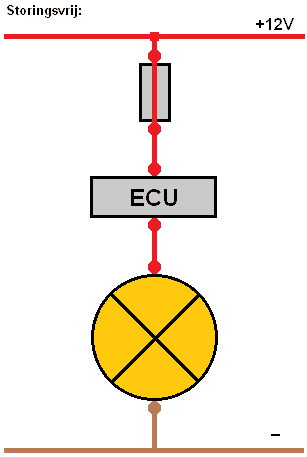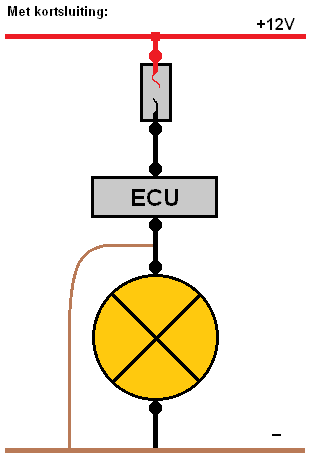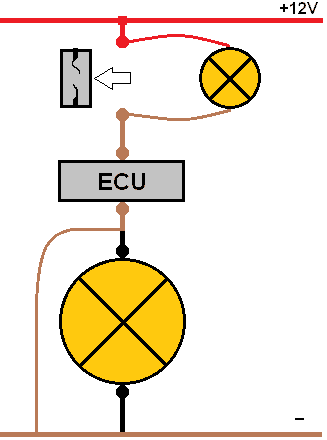Subjects:
- Faulty fuse
- Short circuit in a lighting system
Faulty fuse:
If a fuse blows immediately after it is installed in the fuse holder, two things could be going on;
- The fuse has too low a value. If a 5 Ampere fuse is installed, while the consumer needs 10 Ampere to operate, the fuse will immediately blow when the consumer is switched on. In this case, therefore, no short circuit is present; a fuse with a higher value must be fitted.
- There is a short circuit. The fuse blows to protect the system.
This page describes how to detect the location of a short circuit.
Short circuit in lighting system:
In a trouble-free lighting installation, the lamp lights up as soon as the ECU (the electronic switch) switches the voltage through. There is then a closed circuit, so a current can flow. In the image below (Trouble-free), the plus is marked with red and the ground with brown.
In the picture (titled Short circuit) the plus terminal of the lamp is directly connected to ground. This extra wire is marked with brown in the illustration. In reality, the wires abut each other, so damage to the insulation of two cables can cause them to contact each other.
There must always be a consumer between the plus and minus of the battery. That is not the case with this brown wire in the image below. As soon as the plus of the battery is connected to ground, the fuse will blow.


It can be very difficult to find a short circuit. The short circuit can be located in a wiring harness, but also in the ECU or in a consumer. As soon as a new fuse is installed, it will immediately blow. If a short circuit is suspected, this can be found by inserting a test lamp into the circuit.
Any 12 volt lamp that is used for the lighting installation in the car can be used as a test lamp. Special test lamps are also available at auto parts stores. This test lamp must be connected to the connection points of the fuse (see the diagram). The consumer must be switched on. Once the test lamp lights up, you can be sure that there is a short in the circuit.
As soon as the ECU turns on, the test lamp ground wire is connected to the battery ground, causing the test lamp to light up. In the fault-free situation, the ECU switches the plus, but in this case the ground is switched. Testing with the test lamp does not harm the system. The test lamp is a consumer, so the short circuit will no longer cause an overload.
Now that it is known that there is a short circuit in the system, the location of the short circuit can be found by disconnecting plug connections. In the above diagram, the lamp connections can be disconnected, but the test lamp will remain lit. The connections of the lamp are therefore not the cause of the short circuit.

When the plug is disconnected from the ECU output, the connection to ground is interrupted. The test lamp goes out. With the help of the diagram it can therefore be determined that the short circuit is in the cabling between the ECU and the lamp. Now that the location in the schematic is known, it is easier to find the relevant wire in the car. Repairing the damage or replacing part of the wires is often enough.
